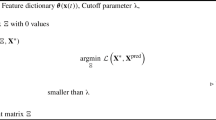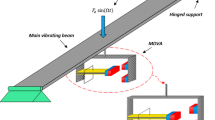Abstract
Analysis of piecewise-linear nonlinear dynamical systems is critical for a variety of civil, mechanical, and aerospace structures that contain gaps or prestress that are caused by cracks, delamination, joints or interfaces among components. Recently, a technique referred to as bilinear amplitude approximation (BAA) was developed to estimate the response of bilinear systems that have no gap or prestress. The method is based on an idea that the dynamics of a bilinear system can be treated as a combination of linear responses in two time intervals both of which the system behaves as a distinct linear system: (1) the open state and (2) the closed or sliding state. Both geometric and momentum constraints are then applied as compatibility conditions between the states to couple the linear vibrational response for each time interval. In order to estimate the response for more general cases where there are either gaps or prestress in the system, a generalized BAA method is proposed in this paper. The new method requires inclusion of contact stiffness and damping to model contact behavior in the sliding state, and new equilibrium positions for each state to establish proper coordinates. The new method also finds the bilinear frequency of the system, which cannot be computed using the bilinear frequency approximation method previously developed since that method is only accurate for the zero gap and no prestress case. The generalized BAA method is demonstrated on a single degree of freedom system, a three degree of freedom system, and a cracked cantilever beam model for various gap sizes and prestress levels.











Similar content being viewed by others
References
Allemang, R.: Investigation of some multiple input/output frequency response experimental modal analysis techniques. Ph.D. Thesis. Mechanical Engineering Department, University of Cincinnati (1980)
Banea, M.D., da Silva, L.F.M., Campilho, R.D.S.G.: Effect of temperature on the shear strength of aluminium single lap bonded joints for high temperature applications. J. Adhes. Sci. Technol. 28(14–15), 1367–81 (2014)
Bennighof, J.K., Lehoucq, R.B.: An automated multilevel substructuring method for eigenspace computation in linear elastodynamics. SIAM J. Sci. Comput. 25(6), 2084–2106 (2004). doi:10.1137/S1064827502400650
Bilotta, A., Faella, C., Martinelli, E., Nigro, E.: Indirect identification method of bilinear interface laws for FRP bonded on a concrete substrate. J. Compos. Constr. 16(2), 171–184 (2012)
Brownjohn, J.M.W., De Stefano, A., Xu, Y.L., Wenzel, H., Aktan, A.E.: Vibration-based monitoring of civil infrastructure: challenges and successes. J. Civ. Struct. Health Monit. 1(3), 79–95 (2011). doi:10.1007/s13349-011-0009-5
Burlayenko, V.N., Sadowski, T.: Influence of skin/core debonding on free vibration behavior of foam and honeycomb cored sandwich plates. Int. J. Non-Linear Mech. (2009). doi:10.1016/j.ijnonlinmec.2009.07.002
Chati, M., Rand, R., Mukherjee, S.: Modal analysis of a cracked beam. J. Sound Vib. 207(2), 249–270 (1997)
Della, C.N., Shu, D.: Vibration of delaminated composite laminates: a review. Appl. Mech. Rev. 60(1), 1–20 (2007). doi:10.1115/1.2375141
Dimarogonas, A.D.: Vibration of cracked structures: a state of the art review. Eng. Fract. Mech. 55(5), 831–857 (1996)
Doebling, S.W., Farrar, C.R., Prime, M.B.: A summary review of vibration-based damage identification methods. Shock Vib. Dig. 30(2), 91–105 (1998)
Doebling, S.W., Farrar, C.R., Prime, M.B., Shevitz, D.W.: Damage identification and health monitoring of structural and mechanical systems from changes in their vibration characteristics: a literature review. Los Alamos National Laboratory Report LA-13070-MS, Los Alamos, NM (1996)
D’Souza, K., Epureanu, B.I.: Multiple augmentations of nonlinear systems and generalized minimum rank perturbations for damage detection. J. Sound Vib. 316(1–5), 101–121 (2008). doi:10.1016/j.jsv.2008.02.018
D’Souza, K., Tien, M.H.: Bilinear amplitude and frequency approximation for nonlinear systems with gaps or prestress. In: Proceedings of the ASME 2016 International Design Engineering Technical Conferences and Computers and Information in Engineering Conference, Charlotte, NC (2016)
Ewins, D.J.: Modal Testing: Theory and Practice. Research Studies Press, Taunton (1984)
Farrar, C.R., Doebling, S.W., Nix, D.A.: Vibration-based structural damage identification. Philos. Trans. R. Soc. Lond. A Math. Phys. Eng. Sci. 359(1778), 131–149 (2001)
Friswell, M.I.: Damage identification using inverse methods. Philos. Trans. R. Soc. Lond. A Math. Phys. Eng. Sci. 365, 393–410 (2007)
Friswell, M.I., Penny, J.E.T., Garvey, S.D.: Using linear model reduction to investigate the dynamics of structures with local non-linearities. Mech. Syst. Signal Process. 9(3), 317–328 (1995)
Guyan, R.J.: Reduction of stiffness and mass matrices. AIAA J. 3(2), 380 (1965). doi:10.2514/3.2874
Ha, N.V., Golinval, J.C.: Damage localization in linear-form structures based on sensitivity investigation for principal component analysis. J. Sound Vib. 329(21), 4550–4566 (2010). doi:10.1016/j.jsv.2010.04.032
Hein, H., Feklistova, L.: Computationally efficient delamination detection in composite beams using haar wavelets. Mech. Syst. Signal Process. 25(6), 2257–2270 (2011). doi:10.1016/j.ymssp.2011.02.003
Hestenes, M.R.: Multiplier and gradient methods. J. Optim. Theory Appl. 4, 303–320 (1969)
Irons, B.: Structural eigenvalue problems: elimination of unwanted variables. AIAA J. 3(5), 961–962 (1965). doi:10.2514/3.3027
Jaumouill, V., Sinou, J.J., Petitjean, B.: An adaptive harmonic balance method for predicting the nonlinear dynamic responses of mechanical systems—application to bolted structures. J. Sound Vib. 329(19), 4048–4067 (2010). doi:10.1016/j.jsv.2010.04.008
Jiang, L.J., Wang, K.W.: An experiment-based frequency sensitivity enhancing control approach for structural damage detection. Smart Mater. Struct. 18(6), 1–12 (2009). doi:10.1088/0964-1726/18/6/065005
Jung, C., D’Souza, K., Epureanu, B.I.: Nonlinear amplitude approximation for bilinear systems. J. Sound Vib. 333(13), 2909–19 (2014)
Kim, T.C., Rook, T.E., Singh, R.: Super- and sub-harmonic response calculations for a torsional system with clearance nonlinearity using the harmonic balance method. J. Sound Vib. 281(3–5), 965–993 (2005)
Ma, O., Wang, J.: Model order reduction for impact-contact dynamics simulations of flexible manipulators. Robotica 25(04), 397–407 (2007)
Newmark, N.M.: A method of computation for structural dynamics. J. Eng. Mech. 85(EM3), 67–94 (1959)
O’Callahan, J., Avitabile, P., Riemer, R.: System equivalent reduction expansion process (SEREP). In: Proceedings of the 7th International Modal Analysis Conference, pp. 29–37. Las Vegas, NV (1989)
Poudou, O.: Modeling and analysis of the dynamics of dry-friction-damped structural systems. Ph.D. thesis, The University of Michigan (2007)
Sairajan, K.K., Aglietti, G.S.: Robustness of system equivalent reduction expansion process on spacecraft structure model validationi. AIAA J. 50(11), 2376–2388 (2012)
Saito, A., Castanier, M.P., Pierre, C.: Estimation and veering analysis of nonlinear resonant frequencies of cracked plates. J. Sound Vib. 326(3–5), 725–739 (2009). doi:10.1016/j.jsv.2009.05.009
Saito, A., Castanier, M.P., Pierre, C., Poudou, O.: Efficient nonlinear vibration analysis of the forced response of rotating cracked blades. J. Comput. Nonlinear Dyn. Trans. ASME 4(1), 011005 (2009)
Saito, A., Epureanu, B.I.: Bilinear modal representations for reduced-order modeling of localized piecewise-linear oscillators. J. Sound Vib. 330(14), 3442–57 (2011)
Shaw, S.W., Holmes, P.J.: A periodically forced piecewise linear oscillator. J. Sound Vib. 90(1), 129–155 (1983)
Shiiryayev, O.V., Slater, J.C.: Detection of fatigue cracks using random decrement signatures. Struct. Health Monit. 9(4), 347–360 (2010)
Theodosiou, C., Natsiavas, S.: Dynamics of finite element structural models with multiple unilateral constraints. Int. J. Non-Linear Mech. 44(4), 371–382 (2009). doi:10.1016/j.ijnonlinmec.2009.01.006
Żak, A., Krawczuk, M., Ostachowicz, W.: Vibration of a laminated composite plate with closing delamination. J. Intell. Mater. Syst. Struct. 12(8), 545–551 (2001). doi:10.1177/10453890122145320
Zucca, S., Epureanu, B.I.: Bi-linear reduced-order models of structures with friction intermittent contacts. Nonlinear Dyn. 77(3), 1055–1067 (2014). doi:10.1007/s11071-014-1363-8
Zucca, S., Firrone, C.M., Gola, M.M.: Numerical assessment of friction damping at turbine blade root joints by simultaneous calculation of the static and dynamic contact loads. Nonlinear Dyn. 67(3), 1943–1955 (2012). doi:10.1007/s11071-011-0119-y
Author information
Authors and Affiliations
Corresponding author
Rights and permissions
About this article
Cite this article
Tien, MH., D’Souza, K. A generalized bilinear amplitude and frequency approximation for piecewise-linear nonlinear systems with gaps or prestress. Nonlinear Dyn 88, 2403–2416 (2017). https://doi.org/10.1007/s11071-017-3385-5
Received:
Accepted:
Published:
Issue Date:
DOI: https://doi.org/10.1007/s11071-017-3385-5




